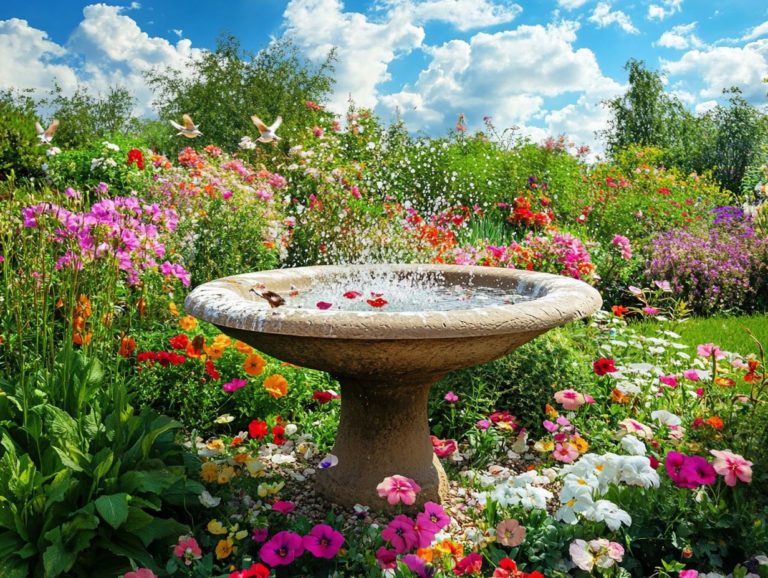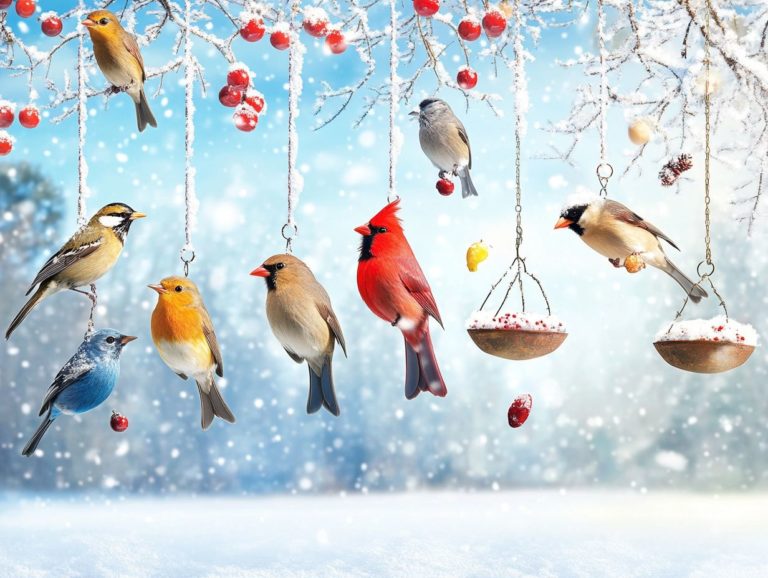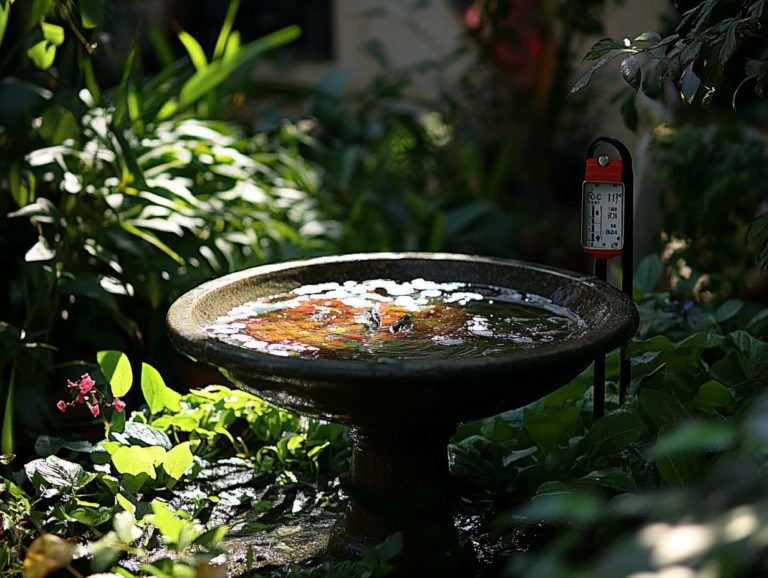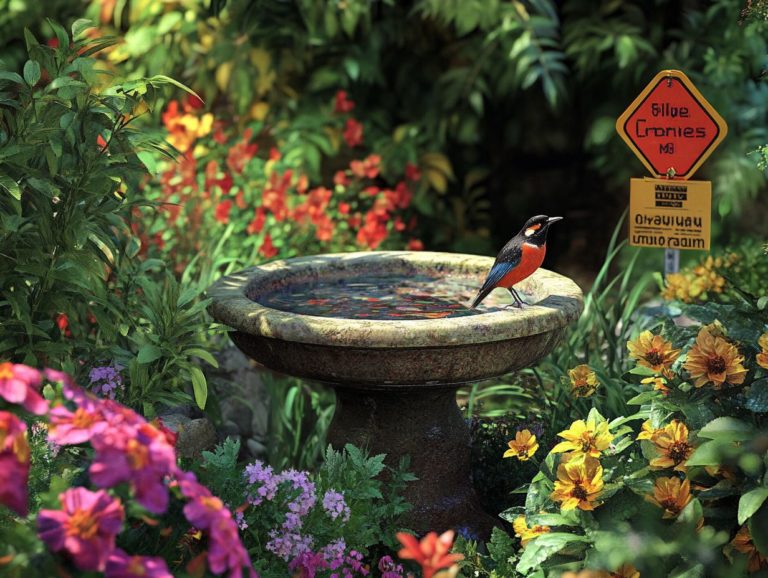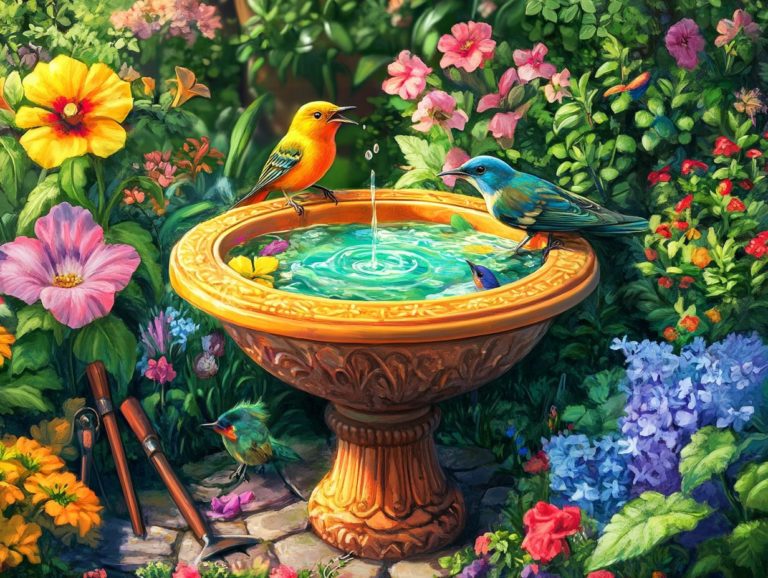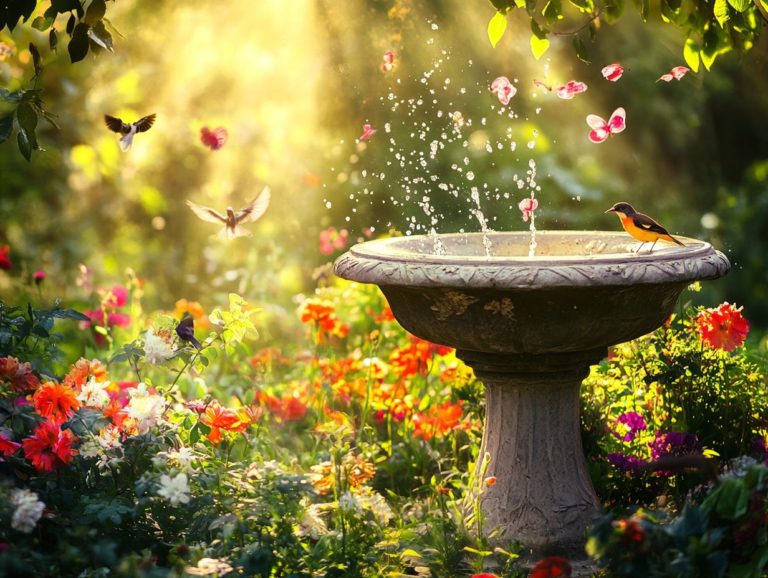Bird Bath Maintenance: Tips for Longevity
A well-maintained bird bath is more than just a charming feature in your garden; it serves as a crucial resource for local wildlife. By ensuring proper maintenance, you create a safe and clean environment for birds to drink and bathe, cultivating a vibrant ecosystem right in your backyard.
This guide offers essential tips for keeping your bird bath in pristine condition. It covers everything from regular cleaning and water replacement to preventing algae growth and winterizing your bath.
Whether you re a seasoned bird watcher or just dipping your toes into gardening, these straightforward strategies will empower you to nurture your feathered friends while enhancing the allure of your garden.
Contents
Key Takeaways:

- Regular cleaning and disinfecting are crucial for maintaining a healthy bird bath. Use a step-by-step guide to ensure thorough cleaning.
- Frequent water changes are necessary to prevent algae growth and keep birds coming back. Aim for at least every 2-3 days.
- Proper winterization and regular repairs will ensure the longevity of your bird bath. Protect it during cold weather and fix common issues promptly.
Why Bird Bath Maintenance is Important
Maintaining a bird bath is vital for the longevity of the fixture and the well-being of your feathered visitors. Following essential bird bath care tips ensures this oasis serves as a dependable source of hydration and a refreshing bathing spot in your outdoor haven.
Regular upkeep is crucial for keeping the bath clean and free from contaminants. This helps prevent diseases like a type of bird disease and salmonellosis that can thrive in stagnant water. By keeping your bird bath in peak condition, you ll attract a diverse array of birds, enriching your birdwatching experience and nurturing a healthy ecosystem.
Benefits for Birds and Your Garden
A well-maintained bird bath offers many advantages. It nurtures a diverse bird population while elevating the beauty of your outdoor space.
By providing a reliable oasis, it attracts various bird species, from vibrant finches to lively sparrows. They are drawn to drink and bathe, contributing to a healthy ecosystem through pest control and pollination. This activity creates a captivating visual display that any gardener would admire.
Clean water is essential for the health and safety of these feathered visitors. It helps prevent disease spread and ensures they have a secure habitat. An inviting bird bath becomes a stunning focal point in gardens, offering both aesthetic appeal and crucial ecological benefits.
Regular Cleaning and Disinfecting
Regularly cleaning and disinfecting your bird bath is essential for preventing algae growth and safeguarding the health of visiting birds. This task is a must for any devoted bird enthusiast.
Step-by-Step Guide to Cleaning
To achieve a sparkling clean bird bath, follow this step-by-step guide. It highlights the significance of an easy-to-clean design and essential maintenance tips.
Start by gathering your must-have materials: a soft brush, a bucket, and a solution of water mixed with non-toxic dish soap or vinegar. This combination effectively removes residue while keeping your feathered friends safe. Tailor your cleaning methods to the material of your bird bath be it ceramic, concrete, or plastic; some surfaces may need a gentler touch.
Aim to perform this cleaning ritual weekly during peak usage months. This helps keep the water fresh and free from algae or debris. Place your bird bath in a shaded area to further reduce algae growth. Regularly check the water levels and refresh the water frequently to create an inviting oasis.
Replacing Water and Adding Fresh Water
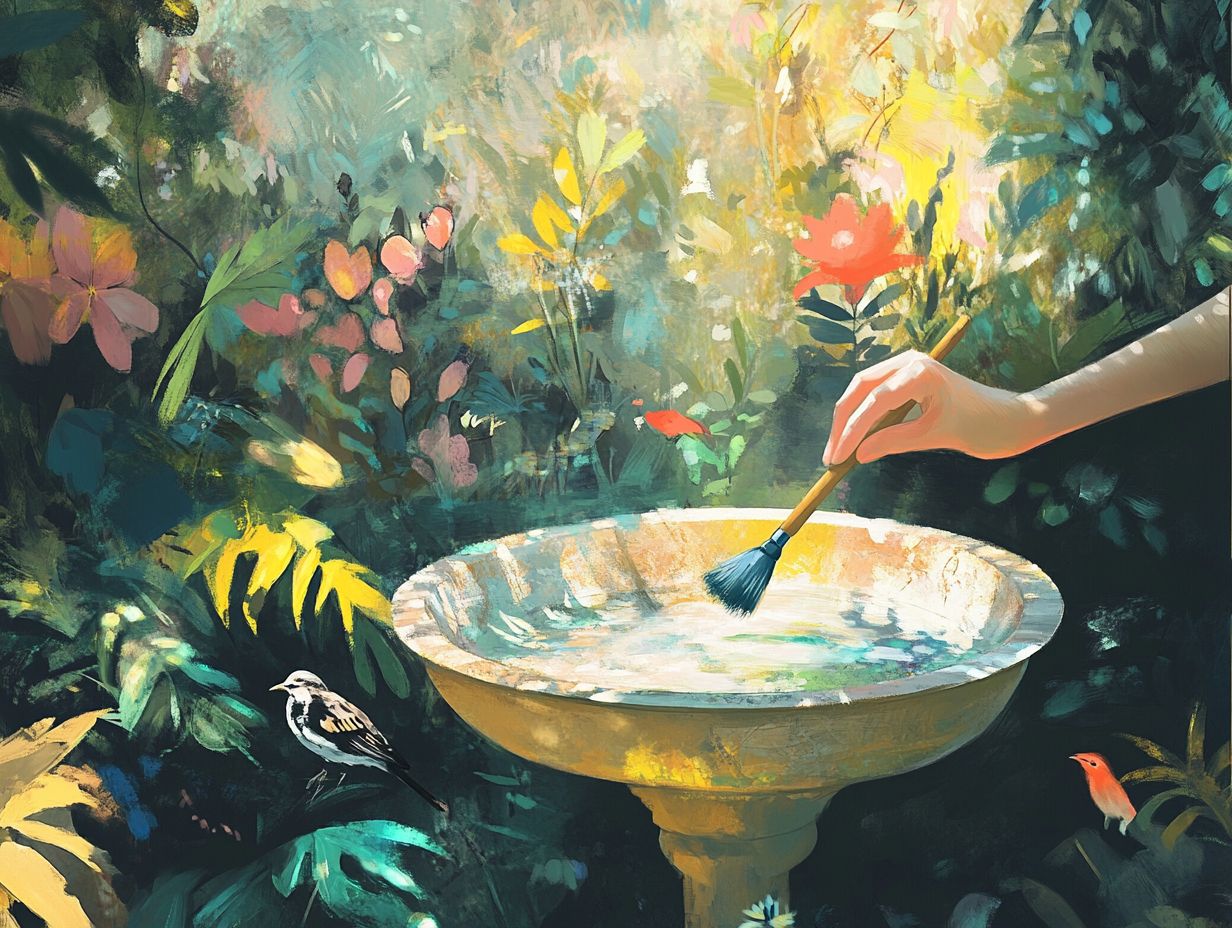
Replacing and adding fresh water to your bird bath is essential for maintaining a dependable water source. This practice not only satisfies the thirst of visiting birds but also diminishes the likelihood of mosquito breeding.
Start maintaining your bird bath today for a thriving wildlife garden!
How Often to Change Water
Changing the water in your bird bath regularly is crucial for keeping it in great shape and ensuring it remains a favorite gathering spot for local birds.
By frequently refreshing the water, you not only keep it clean but also entice more birds to visit, drawn by the allure of fresh, sparkling water. Aim to change the water every two to three days, especially during the warmer months when evaporation happens quickly and bacteria can multiply easily.
In the colder months, while you may not need to change it as often, it s still essential to ensure the water stays clean and unfrozen. This diligent care promotes the health and vitality of the birds that stop by for a bath and helps extend the lifespan of your bird bath, preventing any pesky buildup of algae or debris that could compromise its structure.
Preventing Algae Growth
Preventing algae growth in your bird bath is essential for maintaining crystal-clear water and safeguarding the health and safety of the birds that visit.
It also plays a crucial role in deterring mosquito breeding, ensuring your outdoor space remains inviting and enjoyable.
Tips for Reducing Algae Buildup
To effectively reduce algae buildup in your bird bath, consider these maintenance tips that emphasize both the cleaning process and the creation of a serene outdoor space.
Regularly changing the water is essential; aim to do this every two to three days, particularly during those sweltering summer months. Adding a small fountain can elevate the experience, enhancing water circulation and making it less hospitable for algae while providing birds with the soothing sound of flowing water.
Positioning your bird bath in a shaded area will help minimize sunlight exposure, which promotes algae growth. By keeping your bird bath clean and inviting, you create a charming feature in your garden and nurture the health and well-being of visiting birds, allowing them to thrive in a safe and welcoming environment.
Winterizing Your Bird Bath
Winterizing your bird bath is crucial for preserving its design and functionality throughout the colder months. Taking these steps helps protect the bath and promote the health and safety of the birds that visit your outdoor sanctuary.
Protecting Your Bird Bath During Cold Weather
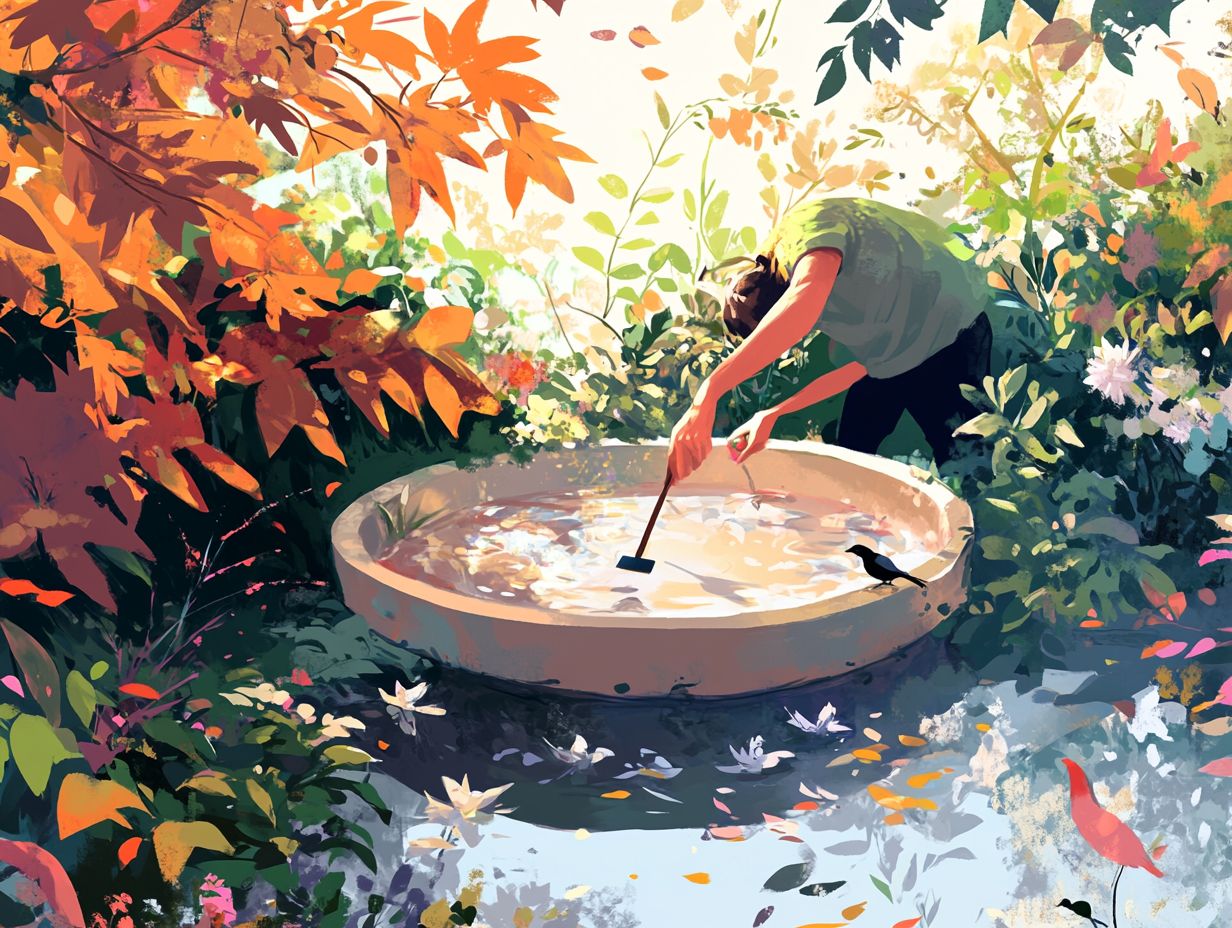
To protect your bird bath during the chilly months, consider strategies that keep it functional while embracing the seasonal charm of your outdoor space.
- One effective approach is to elevate the bath slightly off the ground. This not only helps prevent freezing but also allows for improved drainage.
- Opting for a heated bird bath or incorporating a submersible heater (a device that warms water in the bath) can ensure that the water remains liquid and readily available for your feathered friends.
You can also place shallow containers filled with fresh water in sheltered nooks. These serve as accessible hydration stations for birds seeking a drink during winter. It s vital to maintain these resources, as consistent access to water is crucial for their survival, especially when natural sources are covered in ice.
Repairing and Maintaining the Structure
Repairing and maintaining the structure of your bird bath is essential for guaranteeing its longevity and enhancing its functionality. For more information on this topic, consider the tips in bird bath safety: what to watch for. This attention to detail extends the life of the bath and fosters an inviting environment that attracts a variety of birds to your garden.
Make it a habit to inspect your bird bath often to keep it a welcoming spot for our feathered friends!
Common Repairs and How to Fix Them
Common repairs for bird baths often involve fixing cracks and replacing broken parts. These tasks enhance both beauty and functionality, inviting delightful feathered visitors.
When you notice cracks, use epoxy putty, a strong adhesive designed for outdoor use, to create a durable seal. If parts like the fountain head or basin are damaged, choose weather-resistant materials for replacements to prolong your bird bath s lifespan.
Regular maintenance is crucial. Clean away algae with a mild vinegar solution and check for leaks to keep this essential backyard fixture safe and inviting for local wildlife.
Frequently Asked Questions
What are some tips for maintaining a bird bath for longevity?
Regular cleaning and proper placement are key to keeping your bird bath lasting longer.
How often should a bird bath be cleaned?

A bird bath should ideally be cleaned at least once a week to prevent bacteria and algae buildup.
What is the best way to clean a bird bath?
Use a non-toxic cleaner or a mix of white vinegar and water. Avoid harsh chemicals that can harm birds.
Can a bird bath be left outside during winter? What about seasonal usage?
Yes, but regularly remove ice or snow to prevent damage. Consider using a heater or de-icer to keep the water from freezing.
How can I prevent mosquitoes from breeding in my bird bath?
Keep the water moving with a small pump or fountain attachment. Mosquitoes can’t breed in moving water!
Should I refill my bird bath daily for optimal maintenance?
Make sure to refill your bird bath daily! Fresh water keeps your feathered friends happy.

